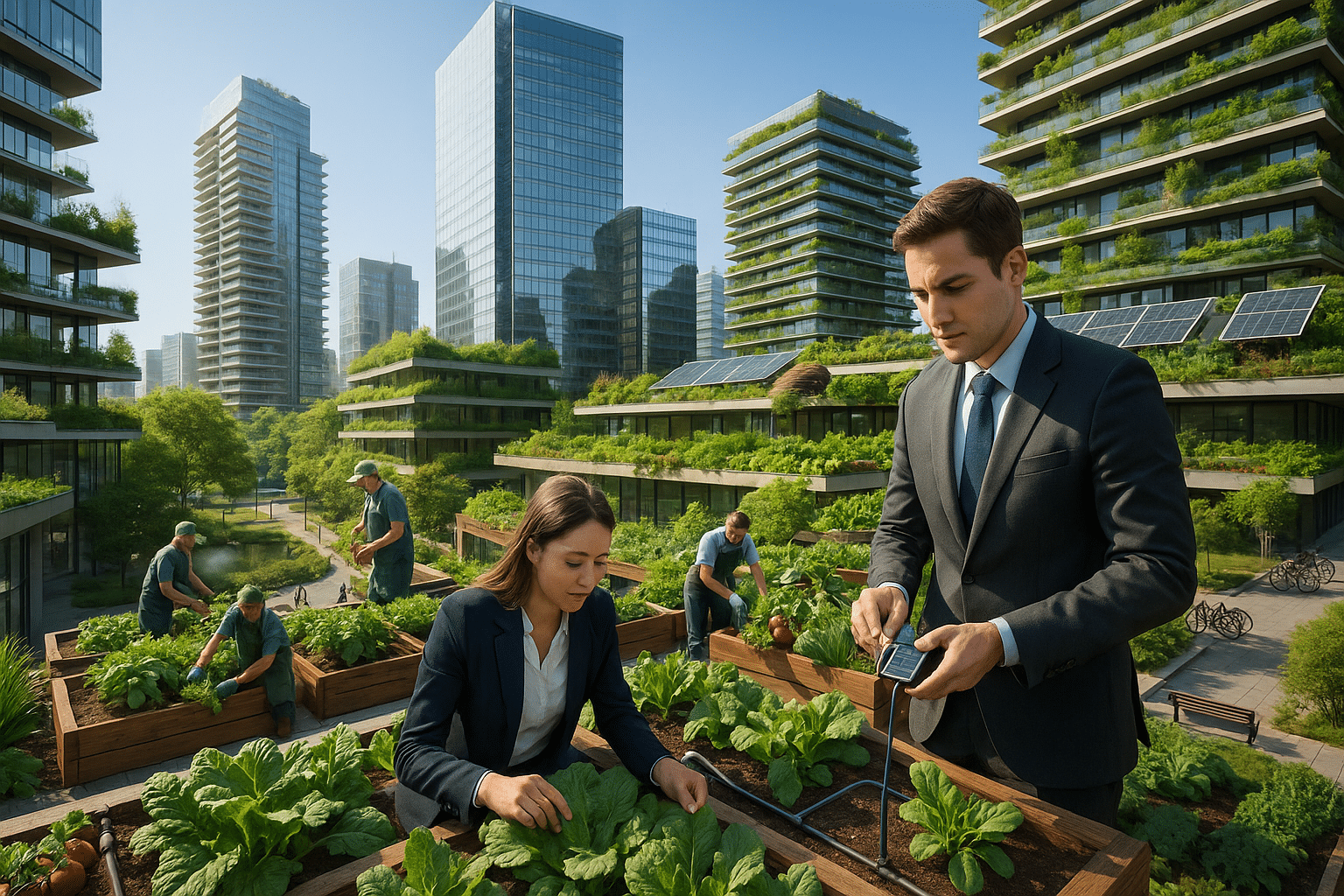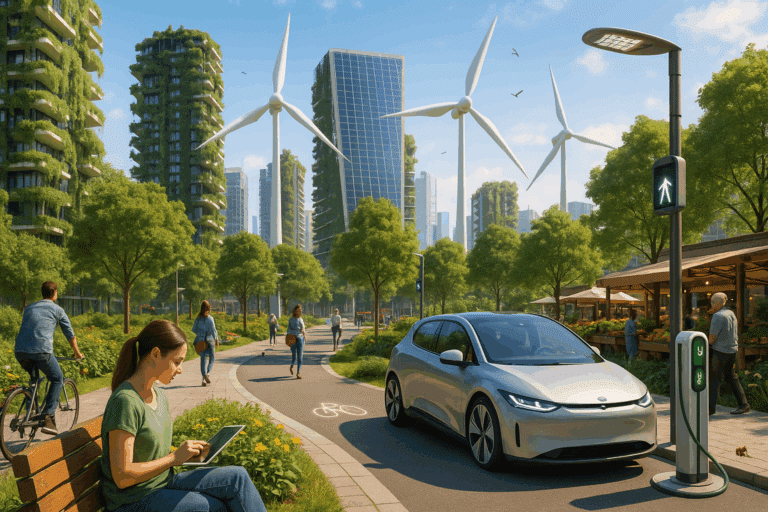A progressive shift towards sustainability, one that’s transforming our urban landscapes in the most unexpected places. 🌿 Corporate gardens and urban farming – seemingly out of place amidst the concrete jungle – are spearheading this evolution, setting an example for businesses and communities alike in integrating eco-conscious practices into their operational blueprint. This, dear readers, is our exploration for today.
As sustainability continues to gain momentum, we’ve witnessed an upsurge in corporations taking the initiative to invest in urban farming and corporate gardens. This new trend isn’t just a symbolic nod to the green movement. It carries with it the promise of increased sustainability, improved employee wellness, and the potential to make a significant contribution to local food security. 😌💚
But what exactly does urban farming entail? And how can it revolutionize sustainability in cityscapes? What does it mean for corporations to turn to gardening? And most importantly, what are the implications for the future of our cities? We’ll delve deep into these questions, uncovering the potential of this green movement, its challenges, and the innovative solutions that are taking shape right in our backyards.
👩🌾 Urban Farming: A Green Oasis amidst the Concrete Jungle
Our first stop on this journey is understanding the concept of urban farming itself. A seemingly straightforward term, urban farming represents much more than just planting seeds in the city. It’s an integrative approach that combines traditional farming techniques with innovative technology, bringing agriculture right to our doorsteps, balconies, rooftops, and empty lots. And as we’ll uncover, its potential to revolutionize urban sustainability is nothing short of astounding.
🌱 Corporate Gardens: The New Green Business Card
Next, we turn our attention to the increasingly popular corporate gardens. These verdant havens within office spaces are not only a breath of fresh air, literally and figuratively, but they also symbolize a company’s commitment to sustainability and employee wellbeing. We’ll look into the ins and outs of corporate gardening, exploring the transformative impact it can have on businesses and their surrounding communities.
🏢 The Role of Businesses in Urban Sustainability
With the rise of corporate gardens and urban farming, businesses are now on the frontlines of urban sustainability. It’s a powerful message, one that says we can, and should, do more than just offset our carbon footprint. We’ll take a close look at how these green initiatives are changing the face of corporate responsibility and the exciting opportunities they offer for future growth.
🚜 Challenges and Innovative Solutions in Urban Farming
And lastly, no exploration would be complete without acknowledging the challenges. Urban farming and corporate gardens are pioneering endeavors, and like all pioneers, they face their share of obstacles. But fear not, for every challenge presents an opportunity for innovation. We’ll explore the hurdles and the groundbreaking solutions that are shaping the future of urban farming and corporate gardens.
So, buckle up as we embark on this enlightening journey, delving into the greener side of cityscapes, and unveiling the groundbreaking potential of corporate gardens and urban farming in revolutionizing urban sustainability. 🌍💪
The Rise of Corporate Gardens and Urban Farming
What if the future of urban sustainability lay in the most unexpected of places – the rooftops and courtyards of corporate buildings? Corporate gardens and urban farming are revolutionizing sustainability in cityscapes, creating a greener, more environmentally friendly future. Let’s dive deeper into this topic to better understand its implications and benefits.
Corporate gardening is an innovative approach to creating more green spaces within urban environments. Companies are transforming their underutilized spaces such as rooftops, courtyards, and terraces into lush, productive gardens. This not only contributes to the greening of urban spaces, but also has numerous benefits for the companies themselves, including improved employee well-being, increased productivity, and even potential cost savings.
Urban farming, on the other hand, is a more intensive form of agriculture that typically takes place within city boundaries. This includes growing fruits, vegetables, and herbs, raising livestock, and even aquaculture. With increasing urbanization and a growing global population, urban farming offers a sustainable solution for food production, reducing the need for long-distance transportation and thus lowering carbon emissions. Check out the video “Urban Farming: A Sustainable Solution to Food Security” by National Geographic for an in-depth look at this topic.
Key Benefits of Corporate Gardens and Urban Farming
Corporate gardens and urban farming come with a host of benefits. These include environmental, economic, and social advantages that are changing the face of urban sustainability.
From an environmental perspective, corporate gardens and urban farms can significantly reduce carbon footprints. They contribute to the sequestration of carbon dioxide, reduce heat island effects in cities, and decrease stormwater runoff. Moreover, locally grown food requires fewer resources for transportation and storage, reducing overall carbon emissions.
Economically, these initiatives can lead to cost savings for companies, as maintaining a garden can be less expensive than traditional landscaping, and can even provide a source of fresh produce for the office. In terms of urban farming, it can create job opportunities, stimulate local economies, and provide affordable, fresh food for communities.
Lastly, the social benefits are equally significant. Gardens and farms in urban settings provide a sense of community, create opportunities for education and engagement, and improve overall well-being by offering a peaceful retreat from the bustling city life.
Comparison of Corporate Gardens and Traditional Landscaping
Now, let’s examine how corporate gardens stack up against traditional landscaping.
| Corporate Gardens | Traditional Landscaping | |
|---|---|---|
| Cost | Potentially lower, with potential for ROI through produce | Can be high, depending on complexity and maintenance |
| Environmental Impact | Positive, with carbon sequestration and reduced emissions | Can be negative, with potential for water waste and chemical use |
| Employee Well-being | Improved through interaction with nature and potential for fresh produce | Depends on design and accessibility |
For a practical example of a thriving corporate garden, check out “The Unlikely Rooftop Garden Feeding a Fortune 500 Company” by Mashable on YouTube.
The Future of Urban Sustainability
Urban farming and corporate gardening are not just passing trends; they are integral components of the future of urban sustainability. As cities continue to expand and natural resources become increasingly strained, innovative approaches to sustainability like these will become ever more critical.
One emerging concept in this field is the idea of “agritecture” – the fusion of agriculture and architecture. This involves integrating food production into the design of buildings, creating self-sustaining ecosystems within the urban fabric. It’s a concept that pushes the boundaries of what’s possible in urban farming and corporate gardening, creating a future where every building not only accommodates people and businesses, but also contributes to local food production and environmental sustainability.
Another future development is the increasing use of technology in urban farming. From vertical farming and hydroponics to the use of AI and robotics for precision agriculture, technology is set to play a key role in the future of urban farming.
Overall, the rise of corporate gardens and urban farming is a positive step towards a more sustainable future. These practices not only green our cities and reduce environmental impact, but also create thriving communities and healthier workplaces. So, whether you’re a city dweller, a business owner, or simply someone interested in sustainability, take a moment to explore the potential of urban farming and corporate gardens in your own environment. You might be surprised by what’s possible.

Conclusion
In conclusion, it’s crucial to recognize that software engineering and Information Technology (IT) are domains of perpetual evolution. As we’ve traversed through the various aspects of these fields in this article, it is clear that staying current and proficient with these changes is vital for all professionals and enthusiasts alike.
We kicked off with a comprehensive overview of software engineering, encapsulating its importance and the multiple facets it comprises. From software design, coding, to software testing and maintenance, each element has a pivotal role to play in the production of robust and efficient software. We also examined the significance of IT in today’s world, underlining how it paves the way for simplified solutions, quicker communication, and better decision-making.
Next, we delved into some of the emerging trends in software engineering and IT, such as artificial intelligence (AI), machine learning (ML), blockchain technology, and cloud computing. These technologies are not just buzzwords, but they are transforming industries, driving innovation, and creating a significant impact.💡 We highlighted how AI and ML are leveraged to develop intelligent systems, how blockchain promotes secure transactions, and how cloud computing is revolutionizing the way businesses operate.
We also emphasized the necessity for continuous learning, as technology continues to progress at a rapid pace. The knowledge and skills required in these fields change frequently, and keeping up-to-date is the key to staying relevant. 🚀
Additionally, we touched upon the challenges faced in these domains and discussed potential solutions. Cybersecurity issues, data privacy, system integration, and ethical considerations are among the few hurdles that need to be overcome.
As we wrap up, remember that software engineering and IT are exciting and dynamic fields with limitless possibilities. It is the synergy of knowledge, innovation, and commitment to continuous learning that will steer us forward. As you take the next step, don’t be afraid to explore, experiment, and question. The technology landscape is vast and inviting, and there’s always something new to learn. 🎓
If you found this article informative, don’t hesitate to share it with your colleagues and friends who might benefit from it. Feel free to drop a comment below with your thoughts or any queries you might have. Your insights and feedback are valuable and much appreciated.💼
For further research and reading, consider the following active resources:
1. Software Engineering Institute at Carnegie Mellon University: https://www.sei.cmu.edu/
2. IEEE Computer Society: https://www.computer.org/
3. ACM’s Special Interest Group on IT Education: https://www.sigite.org/
In the end, the aim is not just to be a spectator but to be a participant in this ever-changing digital era. So, go ahead, explore, learn, innovate, and make your mark! 🚀
References:
[1] Software Engineering Institute, Carnegie Mellon University. (n.d.). Retrieved from https://www.sei.cmu.edu/
[2] IEEE Computer Society. (n.d.). Retrieved from https://www.computer.org/
[3] ACM SIGITE – Special Interest Group for IT Education. (n.d.). Retrieved from https://www.sigite.org/



